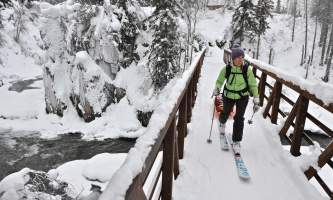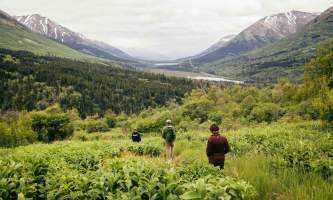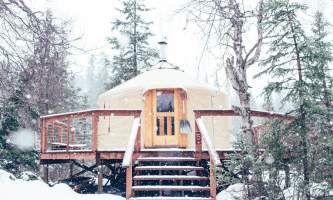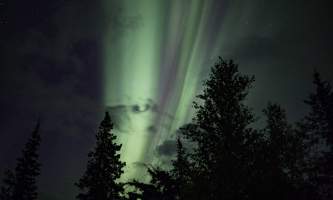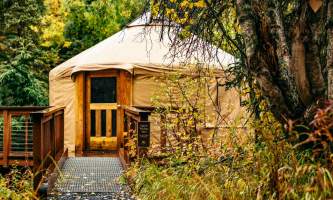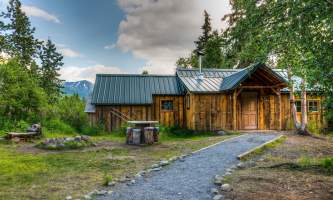Perched at the top of Canyon Creek gorge in a historic mining area next to great skiing and hiking in the Kenai Mountains, Manitoba Cabin offers families and individuals a unique lodging experience. Patrons rent bunks inside two sleeping yurts or one indoor bedroom—and then share communal cooking, dining and social space inside a large, rustic cabin with authentic Gold Rush roots. The setting—on the “wild side” of Canyon Creek beside a multi-use trail that climbs through a hemlock-spruce forest up Manitoba Mountain—has the ambience of old-time Alaskan roadhouse far off the grid. And yet, it’s only about a half-mile walk over trails and historic byways from parking at Mile 48 of the Seward Highway.
Operated by the non-profit Alaska Mountain and Wilderness Huts Association, Manitoba Cabin is intended to promote wilderness experience and camaraderie in the spirit of European-style trekking huts. You might share a campfire with other travelers on their Alaskan adventure, or find your dinner stew anchoring a spontaneous potluck with new friends. While very popular among backcountry skiers during winter weekends, the facility often has openings during weekdays. During the summer, you might have the entire place to yourself.
Amenities
Manitoba offers potential sleeping space for up to 18 people. The main cabin contains a wood heating stove, a propane cook stove with an oven, a French drain for dishwater, counters with benches and tables, and space for stashing gear out of the weather. Fuel is provided. You’ll also find cooking utensils, dishes, cups and silverware—everything you need to prepare your meals except the food. Water must be carried from crystal Canyon Creek and should be sterilized or filtered. A solar panel system powers indoor lights.
Two airy, 16-foot sleeping yurts on platforms each contain four single and two double bunks available for rent. The Spirit Walker Hut features a propane heater with fuel provided and is off-limits to pets. Toba’s Hut features a wood stove and welcomes furry companions. For people seeking more privacy, the cabin offers a “hut keeper’s” bedroom with sleeping space for two that has a propane heater.
Completing the scene are a wood-fired sauna, two pit toilets and a campfire ring famous for S’mores and gatherings that stretch long into Alaska’s dusky summer nights.
What Can You Do at Manitoba?
- Hike and explore. Some of the best hiking routes in the Kenai Mountains are close by. Mills Creek Trail climbs from the cabin to the open slopes of Manitoba Mountain and continues up the valley. Other trailheads within a short drive include Devil’s Creek at Mile 38, Summit Creek at Mile 44, Colorado Creek at Mile 45.5 (across from Summit Lake Lodge) and Fresno Creek at Mile 47 (just across from Lower Summit Lake.) Modern placer miners have also created a network of trails along the creeks.
- Bike: Mills Creek Trail up the mountain and the old road system leading to the cabin are open to cycling.
- Ski. Manitoba Mountain is one of the most popular destinations for backcountry skiing in the Kenai Mountains, known for relatively low avalanche danger and moderate slopes.
- Fish or paddle. Lower Summit Lake is one mile south, and the much larger (and stocked) Upper Summit Lake is three miles south.
- Explore mining heritage. The area surrounding Manitoba helped launch the local gold rush of the 1890s, and active mining continues today. The Lauritsen Cabin dates from the period. Note: You can observe modern mining operations from a safe distance, but do not disturb equipment, remove rocks or minerals, or try to pan for gold. Active claims cover the immediate area.
- View wildlife. Manitoba stands on the opposite side of Canyon Creek gorge from the Seward Highway. The trail and bridge to the facility provide the only practical access to a vast tract of wild land that sees almost no human visitation.
- Pick berries. In August and September, the area produces a great crop.
- Meet people. Unless you’ve rented the whole facility, Manitoba could easily have other patrons sharing the cabin while you’re there. Think of it as a cosmopolitan trekking experience!
Manitoba Cabin and its Mission
Alaska Huts makes the facility available to non-profit and educational groups for reduced rates, especially if the use provides urban dwellers and young people their first exposure to Alaska’s wild country. Alaska Huts has a mission to promote wilderness stewardship and education, and plans to build other huts, too, with the ultimate goal of linking them via trails. The group is currently working with Chugach National Forest and the Alaska Railroad to build a new lodging facility at the Spencer Glacier Whistle Stop.
Historic Roots
The bridge to Manitoba Cabin crosses Canyon Creek just downstream from the confluence of Mills and Lake creeks. Miners working Mills Creek with shovels and wood sluice boxes struck gold in 1895, triggering a rush that brought thousands of prospectors to southern Alaska years ahead of the more famous boom in the Yukon. The Polly Mine became the richest claim in the Cook Inlet Gold Rush, yielding 2,000 ounces of gold worth about $40,000 at the time. That’s more than $1 million in present value. The fortune seekers who followed pioneered the entire region, establishing the mining hamlets of Hope and Sunrise, the towns of Seward and Homer, and scores of smaller settlements and trails.
The Lauritsen Cabin—built by one of the original Mills Creek miners—stands a few hundred yards from Manitoba Cabin and is listed on the National Register of Historic Places as one of the oldest structures in the region. The remnants of ditches, prospects, tailing piles and old equipment can be found throughout the creek bottomland, opening window on a century of small-scale mining. Modern placer operations continue today.
Skiing History
The slopes of Manitoba Mountain above the present Manitoba cabin facility once hosted a small alpine ski venue popular with families and soldiers from Seward. Resident Gentry Schuster built Glacier Ski Lodge in 1941 for personal use, but when World War II brought an influx of soldiers into Seward, the Schusters welcomed all. The lodge had two bedrooms, a dormitory that slept eight, and a loft with open floor space. Gentry ran the rope tow and his wife Virginia cooked and cleaned meals for dozens of skiers.
In 1955, Schuster handed the lodge off to Olivier Amend who ran the place on weekends. Amend used military-surplus vehicles to haul skiers in a sleigh up the mountain. He powered the rope-two with Model A Ford truck engines. Glacier Ski Lodge and its rope tow operated for nearly 20 years, until the lodge burnt down in 1960. (A fire possibly caused by careless trespassers.)
The Alaska Lost Ski Areas Project has posted photos the old days at Manitoba.
Getting There
Parking Area:
Mile 48, Seward HighwayAK
The Manitoba Cabin facility is located in the Kenai Mountains about 70 miles south of Anchorage and 50 miles north of Seward near Mile 48 of the Seward Highway. It’s on Google Maps.
GPS coordinates: 60 40 31.50 N, 149 28 25.20 W
Park in the pullout at Mile 48, about a quarter mile north of the parking area overlooking Lower Summit Lake. From the north end of the pullout, take a single track trail about 200 yards to where it intersects an old road. Head north (left if coming from highway,) cross a bridge over a small gorge and continue another quarter mile to an intersection with another gravel road. Continue north (a sign should point out the fork leading to the hut) down a hill another 300 yards to the sturdy four-wheeler bridge over Canyon Creek. Manitoba Cabin is just across the creek on the bluff
Prices & Dates
| Season | May 1 - Sept 30 |
| Rates | Toba's Yurt (sleeps 8) // $200 Friday and Saturday | $95 Sunday - Thursday |
| Spirit Walker Yurt (sleeps 8) // $200 Friday and Saturday | $95 Sunday - Thursday | |
| Hutkeeper's Quarters ( double bunk, sleeps 2) // $90 Friday and Saturday | $50 Sunday - Thursday | |
| Whole facility (sleeps 18) // $450 Friday and Saturday | $195 Sunday - Thursday | |
| Single bunk in Yurts // $15 Sunday - Thursday | |
| Double bunk in yurts // $15 Sunday - Thursday | |
| Rate Notes | Cost ranges from $15 for a single bunk on weeknights inside one of the two yurts to $450 to rent the entire facility over a weekend night. You must reserve online in advance. Kenai Peninsula Borough sales taxes are added. Alaska Huts members qualify for discounts! |


